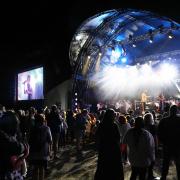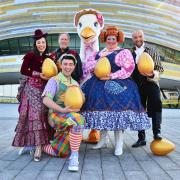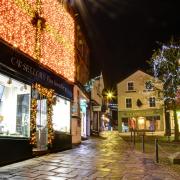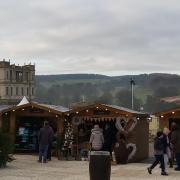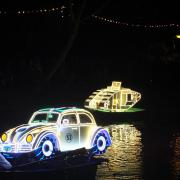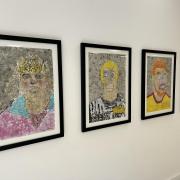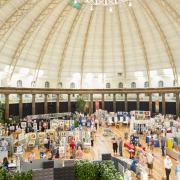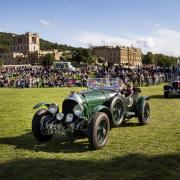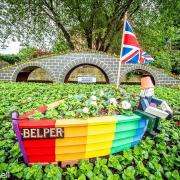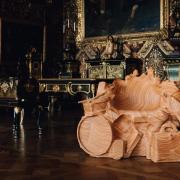Peter Seddon explores the legacy of the disastrous fire which destroyed the old Derby Playhouse sixty years ago

At a time when two former Derby entertainment venues – the Hippodrome and Assembly Rooms – lie unused ‘irreparably damaged’ it is instructive to recall a previous theatrical disaster which produced an entirely different outcome. One that both demands admiration and created the legacy now manifested in the present Derby Theatre which is such a key part of the city’s cultural landscape.
Sixty years ago in the early hours of Wednesday 28th March 1956 the ‘old’ Derby Playhouse in Sacheverel Street was ravaged by fire. The foyer, basement, offices, and dressing rooms were saved, but the heart of the popular theatre – the stage and auditorium – was reduced to a charred roofless shell.
It was not without irony that the conflagration occurred just two days after the theatre premiered The Wick and the Wax – scheduled to be followed by High Temperature. Even in the midst of disaster the Derby Playhouse community saw the joke, and in the same spirit determined on a fresh beginning not a sorry end.
After the years of planning and effort which had created the theatre – then only four years old – the immediate reaction was that the venue must and would rise again ‘like a phoenix from the ashes’. Only a day after the tragedy theatre manager Moyadel Johnston told the Derby Evening Telegraph: ‘Already we are anticipating the opening night’.

Such stoicism in the face of cruel misfortune speaks volumes, especially as it quickly became apparent that the insurance settlement was entirely insufficient for the job in hand. As such fund-raising, lobbying and selfless volunteering became the order of the day as a new vision took shape.
This spirit of engagement stemmed from the acute sense of ‘ownership’ that the supporters of Derby Playhouse had already engendered in its short life, for most had been ‘present at the birth’ and felt a deep sense of pride in their creation. A glance at its pre-history explains why.
This theatrical journey had begun in 1948 when the Derby Telegraph revealed that a group of theatre lovers was preparing to launch repertory in Derby. Within three months – on 1st November 1948 – in a small converted school room at the end of a passage off Becket Street, the curtain went up in the resulting Derby Little Theatre for the first time.
The town responded admirably to the bold venture, 3,000 members subscribing to the Derby Little Theatre Club launched to support it. The productions proved popular although evidently leaving more to be desired. One critic observed: ‘That rollicking farce of naval misadventures The Middle Watch commenced proceedings, but on a pocket-sized stage, in surroundings of humble obscurity, caused no flutter in the dovecotes of the nation.’ Ouch!

Indeed the Becket Street hall was never deemed worthy of a stage licence and all performances were ‘private’ to club members and their guests. Something better was needed. The Becket Street prologue lasted through four seasons of hope and frustration before its pioneering era came to a close.
One man in particular led the campaign for a new Derby Playhouse to replace it – of Mr JS Selby the Chairman of The Little Theatre it was written: ‘His goal from the start was a new theatre; tirelessly he coaxed, cajoled, bullied and charmed producer, players and audience alike into a state of worthiness of the New Playhouse.’
The opportunity for acquiring this ‘real Playhouse’ came through the generosity of Mr William Hadden Richardson, who offered a lease of the substantial old Baptist Church Hall in Sacheverel Street, with a very generous contribution towards the cost of conversion. The building was entrusted in Spring 1952 to Messrs Ford and Weston Ltd who transformed it into a theatre in six months.
This ‘new’ Derby Playhouse first opened its doors to the public on 1st October 1952. Banished were the old ‘membership’ restrictions and sundry discomforts – one reviewer wrote: ‘It has a splendid stage and comfortable auditorium, freedom to smoke, and to stroll and chat at intervals, and the blessed privilege of a licensed bar – luxury to the patient enthusiasts who had awaited them so long.’

The first production, J B Priestley’s When We Are Married, was well-received. Many and varied others followed and four seasons of devoted work earned Derby Playhouse a national reputation. Even so, money was always tight, but the support of club members and corporate sponsors – especially Rolls Royce Ltd – helped this new Derby Playhouse survive.
Thus matters stood when the disastrous fire struck in March 1956 – and by then so much time and effort had been invested in ‘getting there’ that the easy option of giving up and closing down proved simply unthinkable.
It fell mainly to the ‘middle-class’ theatre-lovers – backed by Derby’s professional and business community – to set about the rebuilding task. On the day after the fire the scene looked truly desolate – the charred ranks of the auditorium seats likened to ‘a surrealist field of the dead’ – but within days the Playhouse Board of Management had launched a £10,000 Reconstruction Fund.
Rolls Royce gifted £2,500 and further offered to double ‘pound-for-pound’ any other sum raised up to £2,000. Support also came from the Council of Repertory Theatres, a body firmly pro-Derby after staging a successful conference there the previous year. In addition countless individual playgoers organised whist drives, jumble sales, raffles and ‘ingenious efforts of many kinds’. Some pensioners contributed mere pennies – but every little helped.

Through this collective effort the £10,000 was soon raised – and in October 1956 just seven months after ‘the blazing inferno’ Ford and Weston were again set to work rebuilding the theatre they had created just four years earlier.
Can the devastating 1956 fire be compared with the one which damaged part of the infrastructure of Derby’s currently ‘mothballed’ Assembly Rooms in 2014? The contrasting outcomes certainly beg a question: ‘What did the 1950s have that is now lacking’? Some might suggest greater determination, more public-spiritedness and genuine civic pride. Others would counter that the 1950s were simply ‘different times’ offering solutions impossible to apply in today’s complex climate. The debate could easily divide opinion. But what remains unequivocal is that the substantially destroyed Derby Playhouse did rise again – adopting as its symbol the fiery phoenix from Greek mythology which rose again from its ashes.
The 400-seat New Derby Playhouse – today remembered as the ‘old’ – re-opened on 25th April 1957 with the aptly-titled French comedy My Three Angels. From there it never looked back. Progressing from weekly rep to fortnightly in 1960 it drew some good names to its company – some already well-known but others who found stardom later, among them film actress Susannah York and TV’s John Nettles of Midsomer Murders fame.
Indeed across the theatrical spectrum many cut their teeth in Derby, not least game-changing playwright John Osborne (see Nigel Powlson’s article on page 57) whose excoriating take on the ‘smug middle classes’ might well seem uncharitable to the stalwarts who created the Derby Playhouse success story.
And so the journey progressed – until two decades later it was decreed that Derby should have an even better new Playhouse. The old theatre closed on 31st May 1975 with a production of the rock opera Tommy that ‘shook the building’.
Its successor, the new purpose-built Derby Playhouse in the Eagle Centre, opened in September 1975 with the musical My Fair Lady. It too made a tremendous contribution to Derby’s theatre scene before succumbing to financial difficulties and briefly ceasing operations in 2008. It re-opened in 2009 under the ownership of The University of Derby as the current Derby Theatre – the fifth entity in a line which all began with the Derby Little Theatre in Becket Street in 1948.
As for the old Derby Playhouse building in Sacheverel Street it first lay boarded up before re-emerging as the Ajanta Cinema showing Asian films. Briefly in 1977 it also screened uncensored adult films. This culturally-disparate afterlife concluded as the Ajanta Theatre staging new wave and punk music gigs up to the early-80s – indeed the Ajanta is considered legendary for some of the influential names that appeared there.
Alas its final end betrayed scant respect for ‘heritage’. A succession of raucous gigs took its toll – on one occasion seats ripped out and hurled onto the very stage where Charley’s Aunt and The Glass Menagerie had once packed them in (they’re plays not punk bands!). The Sacheverel Street landmark staged its last entertainment performance in the early 80s and was finally demolished in January 1988.
History it may be, but a few who began the journey in Derby Little Theatre in 1948 and followed its entire course to the Derby Theatre of today are yet still with us. To them and their late colleagues a curtain call seems wholly due.
Celebrating the post-fire re-opening of the Sacheverel Street Playhouse in 1957 Andrew Cavendish the 11th Duke of Devonshire sagely observed: ‘These are difficult times for the living theatre, and the reopening of the Playhouse will take its place in Derbyshire history as a notable act of faith.’






